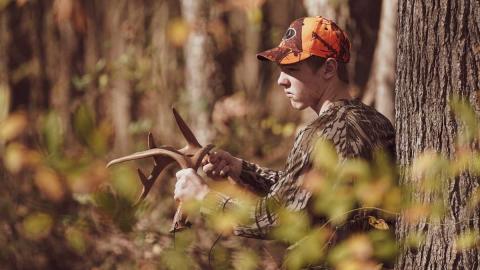Kat Ainsworth
Whether you’re about to wade into flooded timber for the first time or are a seasoned waterfowler looking for new ideas, this is for you. Hunting flooded timber is preferred over other methods by many duck hunters — and for good reason. There’s nothing quite like it and for me, personally, it’s resulted in some of my favorite duck hunting memories. It’s church, only for waterfowlers. The towering oaks and shimmering water are the cathedral and the ducks flying overhead are the choir. Let’s get started on the sermon.
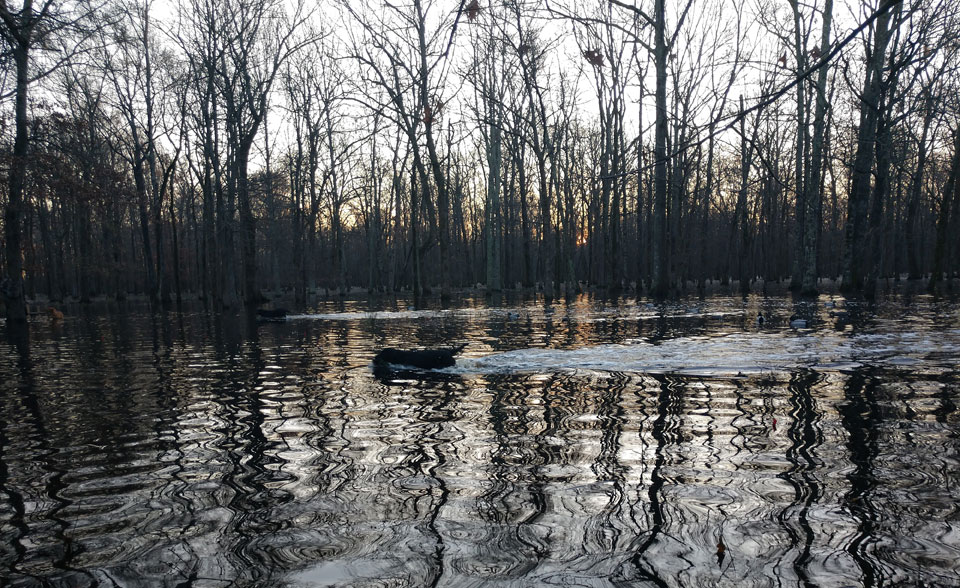
Choose Your Spot…But Remain Fluid
Selecting a location in flooded timber, or what is otherwise known as green timber, is about far more than simply wading into the trees and hoping for the best. Just as with hunting any species, scouting matters. Becoming familiar with the land and the locations the ducks prefer to congregate is a must. Aside from the ducks themselves, you’re looking for a hole, a natural clearing in the timber large enough to attract ducks flying overhead while providing cover for you around the edges.
If you have permission to hunt someone else’s land, talk to the landowner to find out if they’re aware of good spots. Not every landowner is a duck hunter, so it pays to check out their recommendations ahead of time. Just because they see a wood duck or two doesn’t mean it’s a good place for timber duck hunting. A little coffee and conversation with the landowner will let you know if there are really ducks there. Otherwise, you’ll need to do your own scouting.
If you are going to do your own in-field scouting, go at dawn and dusk with binos and a good-sized dose of patience. Make sure the binos are capable of handling those necessarily longer distances, too. Use something like the Styrka S7 10x42 binos which have extra-low dispersion objective lenses for superior clarity and are multi-coated for superb color and light transmission.
Duck Hunting and Research
Consider utilizing the United States Geological Survey topographical maps. Topo maps show swamps and clearings as well as access to those locations. With that in mind, invest in a good GPS such as the Garmin GPSMAP 66st Handheld Hiking GPS, a model that comes with preloaded topo maps and wireless connectivity. It also has buttons, something I prefer over touchscreens for hunting. Using a GPS enables you to keep track of routes and potential hunting holes.
There are also a number of hunting apps that have great graphics for locating potential duck-hunting opportunities. They are not going to show you mallards flying in at dawn, but they are incredibly detailed. You can drop a pin anyplace on the map and you have this information with you anywhere you carry your phone. Most of these maps are updated and often show the green timber you're looking for. Depending on the app you use, some will detail property lines and list the landowner for that piece of property.
Of course, you’re not only looking for a good hole with a break in the canopy. Look for backwater spots where the water isn’t too high; truly deep water translates to a lower likelihood of ducks coming in. Monitor water levels. Keep an eye out for acorns, too. Acorns in the water are a stellar attractant for ducks. Watch for white oak trees which are long-lived, top producers of acorns and can be easily identified by their light gray bark. Yes, the ability to identify trees comes in handy.
Remember that there are a lot of high-pressure areas out there, especially on public land. It won’t do you much good to hit spots that are burned out from excessive shooting and human presence. However, around heavily-trafficked flyways, there are also going to be smaller holes where ducks feed and rest without feeling pressured. Branch out. Don’t assume you must focus on popular spots. Try scouting out-of-the-way spots such as those located directly between major flyways where ducks may stop to rest and feed. As a single hunter – or perhaps two – you can easily hunt a small, low-pressure hole with fantastic success.
Camouflage for Waterfowl Hunting
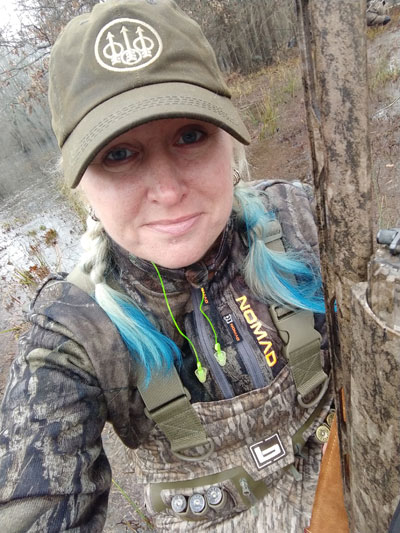
This might seem obvious but I’m going to say it anyway: camo up and hide yourself. Wear patterns that blend into your surroundings – I’m a huge fan of Mossy Oak Bottomland, Ducks Unlimited’s official camo for flooded timber – and put on an equally earth-toned hat. It’s a camo that works from Mississippi to Arkansas. When you reach your chosen hole, position yourself so the sun will be at your back. Rays of sun shining directly at your face will light you up like a neon sign and the ducks will see you before you can get a shot off.
Clear days are far better for timber duck hunting than overcast ones. Even better if several overcast days are followed by a break in the weather. As for the wind, you’re looking for a happy medium. You don’t want the wind roaring through the trees, but you also don’t want utter stillness. Hope for a prevailing wind and position yourself so the wind is directly or quartering at your back. This gives you the best shot at ducks coming in for a landing.
Hug your tree and don’t flash your bright face at the sky. Exactly where you need to stand will change as the sun rises, so pay attention. Stick to the shadows and refrain from tilting your head too far back when scanning the sky. If you need to create movement in the water with your booted feet, don’t do it on closely working ducks. Create ripples when ducks are moving away from your position, not toward it.
Calling All Waterfowl
There’s a lot of competition out there for the attention of ducks everywhere. If your skills aren’t up to the task, get some practice. Good calling skills are vital to a successful hunt. Without getting too detailed, here are a few tips: do not overcall, learn to control your volume and educate yourself on factors such as timing. Work on it at home — not until you get it right, but until you cannot get it wrong. Oh, and master more than one call.
If you are just learning about waterfowl hunting, it’s a good idea to go with a seasoned duck hunter. You can learn a lot from them, especially when it comes to calling ducks. Don’t shy away from calling when it’s time. It’s the only way to see if your calling skills are up to par. Be prepared for a little ribbing. Duck hunters love to give a rookie the business. It doesn’t take long, though! Stick with it and you will have ducks in your lap.
Decoy Strategy
Many duck hunters like to use magnum decoys for flooded timber but you’ll find a number of seasoned hunters eschew them in favor of standard-sized decoys. Don’t feel you have to invest in magnum decoys in order to be successful. What you need to focus on is placement.
As with hunting in any location, your goal is to create a seemingly duck-friendly environment with a good landing zone (remember, the LZ should work well with your position at the edge of the hole). Ducks do some things predictably: come in for final approach flying into the wind and avoid flying directly atop other ducks’ heads. Keep those things in mind when placing decoys and don’t forget to make use of a jerk string to create some movement in your spread. Swimmers are fantastic for creating ripples in flooded timber and drawing the attention of ducks overhead. If it’s a gorgeous bluebird day with a chill in the air, that motion can and will be seen from miles away, drawing greenheads to you like a magnet.
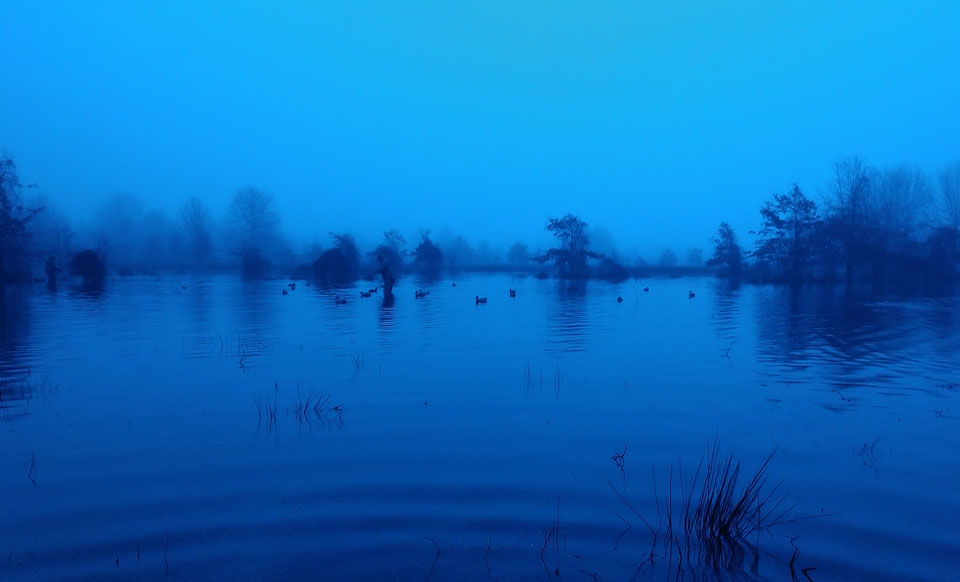
Waterfowl Hunting and Patience
One mistake many duck hunters make is calling it a day too soon. Rather than giving up at 9 a.m. or 10 a.m., try sticking it out until closer to 1 p.m. Late-morning ducks are a possibility you should not discount. Staying longer takes patience, but it’s hard to do if you haven’t planned for it. Make sure you are aware of any mid-morning weather changes and dress accordingly. An extra thermos and a few snacks for you and your canine companion can help you both stick it out. Also, let your hunting partners know you are planning on a long sit. You don’t want them wading out early. It seems ducks always show up when someone is moving around. Know the laws in your area, though. For example, Wildlife Management Areas – WMAs – in Arkansas close to waterfowlers at noon.
Man’s Best Friend
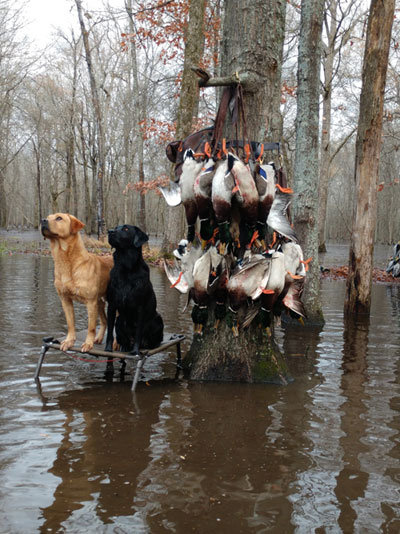
A word on dogs. Your dog is not impervious to cold, especially when he’s wet. Use a dog stand to keep them out of the water and give them a better line of sight. Even your dog stand benefits from camo to obscure its outline, so use one such as the Avery Boomer Dog Stand in Mossy Oak Bottomland. Vests are also a good idea for gun dogs. Not only do they trap body heat to keep your dog warmer, they protect your dog from punctures and scrapes. Brush, ice and unseen obstacles can all cause injuries on unprotected dogs. Improve your dog’s comfort, health and safety by using a vest like the Avery ASD Bodyshield Pro Dog Parka when hunting flooded timber. Avery’s vest is made using 5mm neoprene, has an internal harness and handles and is patterned in Mossy Oak Bottomland. Your dog is your best hunting buddy and a hard worker. Take excellent care of him.
Remember
It’s supposed to be fun. All the mapping, scouting, researching and practicing can become a chore rather than an enjoyable investment into your favorite pastime. All the preseason effort is more fun when you let your young hunter in on it. Show them what you are looking for on a map or bring them along with their own set of binos. Watching them do the things it takes to be a successful duck hunter is fulfilling. The hunting experience has more meaning when you share it with a youngster. Don’t lose sight of the simple fact that duck hunting rocks, flooded timber is awesome and you’re going to be smashing ducks in no time.















